|
|
|
Sort Order |
|
|
|
Items / Page
|
|
|
|
|
|
|
| Srl | Item |
| 1 |
ID:
136045
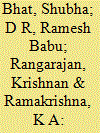

|
|
|
|
|
| Summary/Abstract |
Research on vision-based navigation of unmanned air vehicles (UAVs) has been in focus in the recent years, both in military and civilian application domains. Vision-based navigation uses features as cues to match successive images and compute the location of the UAV. The method proposed in this paper is an extension to the existing work to automatically compute scale weights of dual-tree complex wavelet transform (DTCWT) coefficients to improve the performance in terms of detection of features as against discrete wavelets or its Fourier counterparts. Existing DTCWT coefficients give improved time-shifted sensitivity, better directional selectivity with local phase information and limited redundancy. However, the drawback of this method is that the results depend on appropriate selection of scale weights α and β, which are different for different scenes. The existing technique incorporates a rule of thumb-based recommended values of α and β, irrespective of the scene which generates too many key-points, making the registration process computationally intensive. As a real-time application, the need of the problem is to extract less number of strong features. Thus, an algorithmic approach to compute optimal values of scale weights considering precision and accuracy is proposed. The method is tested on various synthetic, simulated, and aerial images having different transformations and in the presence of noise between successive images. It is observed that DTCWT descriptor performs the best and gives better results than scale invariant feature transform and Speeded up robust features.
|
|
|
|
|
|
|
|
|
|
|
|
|
|
|
|
| 2 |
ID:
136047
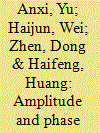

|
|
|
|
|
| Summary/Abstract |
Amplitude and phase statistics of SAR complex interferogram are significant in the study of interferometry and polarimetry. To reduce statistical variations, multi-look processing is adopted by averaging spatially the complex interferogram. In this study, we derive and validate three kinds of probability density functions (PDFs) of multi-look interferogram for different surface feature scenes. For simple homogeneous areas with the gamma distribution intensity, a concise product-form interferometry phase PDF is derived, which is equivalent to a conventional Gauss hypergeometric PDF. For complicated areas with the K and G0 distributions intensity, two new interferometry amplitude PDFs named as Gamma-K and Gamma-G are proposed, and their phase PDFs are approximately preserved. Finally three typical areas including grass, mountain, and city are picked out from a pair of RADARSAT-2 SAR images and studied. Experimental results indicate good agreement between the computed histograms and the theoretical distributions. The results obtained can be applied to the feature classification of polarisation SAR data and the estimation of decorrelation effect of interferometric SAR.
|
|
|
|
|
|
|
|
|
|
|
|
|
|
|
|
| 3 |
ID:
136038
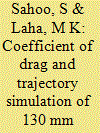

|
|
|
|
|
| Summary/Abstract |
In the present study, the drag variation and trajectory elements estimation of a supersonic projectile having two different nose shapes are made numerically. The study aims at finding the coefficient of drag and shock wave pattern for 130 mm artillery shell fitted with recovery plug or with fuze, when travelling at zero angle of attack in a supersonic flow of air. The coefficient of drag (CD) obtained from the simulation is used as an input parameter for estimation of trajectory elements. The numerical results, i.e., the coefficient of drag at different Mach numbers and trajectory elements are validated with the data recorded by tracking radar from an experimental firing. Based on numerical results and data recorded in experimental firing, the coefficient of drag in the case of the shell with recovery plug is 2.7 times more than for the shell with fuze. The shock wave in the case of the shell with recovery plug is detached bow shock wave, whereas in the case of a shell with fuze, the shock is attached. The results indicate that the coefficient of drag increases with detached shock wave and an increase in the radius of the shell nose. Good agreements were observed between numerical results and experimental observations.
|
|
|
|
|
|
|
|
|
|
|
|
|
|
|
|
| 4 |
ID:
136040
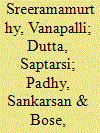

|
|
|
|
|
| Summary/Abstract |
Source localisation is a method to estimate position of a source. In case of acoustic source localisation (ASL), the location of sound source is estimated using acoustic sensors such as a microphone. In case of ASL, time difference of arrival (TDOA) from each pair of microphones is estimated. For any pair of microphones, the surface on which the TDOA is constant is a hyperboloid of two sheets. Then the source location is estimated at the point where all associated hyperboloids most nearly intersect. This concept has been used in our range in finding the point-of-burst of artillery shell using an array of sensors. In this paper, a simulation model has been developed to examine the applicability of acoustic source localisation for determining point-of-burst of artillery shells. The randomness in the model has been incorporated in terms of gustiness of downrange sea wind. The result of the simulation has been validated with trajectory data of projectiles tracked by radar. Finally, an acoustic sensor array-based setup has been developed and used for localising point-of-bursts.
|
|
|
|
|
|
|
|
|
|
|
|
|
|
|
|
| 5 |
ID:
136039
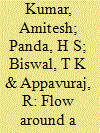

|
|
|
|
|
| Summary/Abstract |
Flow around a conical nose with rounded tail projectile has been studied numerically for subsonic, transonic and supersonic flow regimes. The conic angle of the projectile is 10°. The inflow Mach numbers are 0.5, 0.9, and 1.5. Axisymmetric Euler’s equations are solved for predicting the drag coefficient. It has been observed that even for a subsonic flow regime, the Mach number distribution is not uniform owing to the non-symmetric shape of the projectile. The predicted drag coefficients for subsonic, transonic, and supersonic cases are 0.018, 0.089, and 0.395, respectively. It was observed that rounded tail is a better option than boat tail so far drag force is concerned.
|
|
|
|
|
|
|
|
|
|
|
|
|
|
|
|
| 6 |
ID:
136044
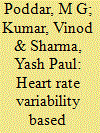

|
|
|
|
|
| Summary/Abstract |
The aim of this study is to analyse and compare the heart rate variability (HRV) of normal and hypertension cases using time domain, frequency domain, and nonlinear methods. For short term HRV analysis, a five-minute electrocardiogram (ECG) of 57 normal and 56 hypertension subjects were recorded with prior verification of their clinical status by a cardiologist. Most time domain features of hypertension cases have clearly reduced values over normal subjects, frequency domain features, like power in different spectral bands, also have the distinguishable decreased values, whereas sympathovagal balance has clear edge over hypertension cases than normal cases. Nonlinear parameters of Poincare plot, approximate entropy and sample entropy, have higher values in normal cases when compared with hypertension cases. Support vector machine-based binary system classifies these two classes with 100 per cent accuracy and 100 per cent sensitivity when all time domain, frequency domain, and nonlinear features were used. It may work as a better predictor for in patients with hypertension.
|
|
|
|
|
|
|
|
|
|
|
|
|
|
|
|
| 7 |
ID:
136046
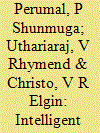

|
|
|
|
|
| Summary/Abstract |
Wireless sensor networks (WSNs) are extensively used in military applications for border area monitoring, battle-field surveillance, tracking enemy troops, where the sensor nodes run on battery power. Localisation of sensor nodes is extremely important to identify the location of event in military applications for further actions. Existing localisation algorithms consume more energy by heavy computation and communication overheads. The objective of the proposed research is to increase the lifetime of the military sensor networks by reducing the power consumption in each sensor node during localisation. For the state-of-the-art, we propose a novel intelligent unmanned aerial vehicle anchor node (IUAN) with an intelligent arc selection (IAS)-based centralised localisation algorithm, which removes computation cost and reduces communication cost at every sensor node. The IUAN collects the signal strength, distance data from sensor nodes and the central control station (CCS) computes the position of sensor nodes using IAS algorithm. Our approach significantly removes computation cost and reduces communication cost at each sensor node during localisation, thereby radically extends the lifetime and localisation coverage of the military sensor networks.
|
|
|
|
|
|
|
|
|
|
|
|
|
|
|
|
| 8 |
ID:
136043
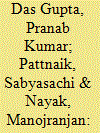

|
|
|
|
|
| Summary/Abstract |
Static images of colour clouds play an important role to predict weather conditions to schedule proof and trial activities, and deploying resources at firing locations and observation posts. In this paper, a new inter-level cloud compression architecture and algorithm has been presented. Distributed architecture suitable for cloud computing has been suggested to implement inter-level compression algorithm (ILCA). Different possibilities between two successive cloud images have been combined to save the images of interest for further processing, ignoring the redundant ones. Vector quantisation technique is briefly discussed to achieve high level of compression. The algorithm presented in this paper can be easily modified to store flying, floating, and moving objects in air, water, and surface, respectively with high level of compression in various defence applications.
|
|
|
|
|
|
|
|
|
|
|
|
|
|
|
|
| 9 |
ID:
136037
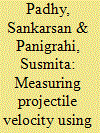

|
|
|
|
|
| Summary/Abstract |
This paper deals with development of velocity measurement methodology based on projectile shock wave pressure measurements. The measurement principle is based on the fact that, whenever a projectile moves with supersonic velocity, shock wave fronts are produced along the trajectory of the projectile. Measurement configuration has been developed for measuring the shock wave pressure associated with projectile in flight, and hence, projectile velocity has been calculated. This paper covers various aspects of shock waves, generation of N Waves, feasibility study for capturing shock wave using dynamic microphone. Finally, suitable piezo-electric sensor has been selected and deployed in the trials and shock wave signature has been captured. From shock wave pressure, the projectile velocity has been computed.
|
|
|
|
|
|
|
|
|
|
|
|
|
|
|
|
| 10 |
ID:
136042
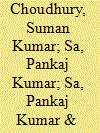

|
|
|
|
|
| Summary/Abstract |
Deformation study of projectile immediately after firing is essential for its successful impact. A projectile that undergoes more than the tolerated amount of deformation in the barrel may not produce the requisite results. The study of projectile deformation before its impact requires it to be imaged in flight and perform some computation on the acquired image. Often the deformation tolerance is of the order of tens of micrometer and the acquired image cannot produce image with such accuracy because of photographic limitations. Therefore, it demands sub-pixel manipulation of the captured projectile image. In this work the diameter of a projectile is estimated from its image which became blur because of slow shutter speed. First the blurred image is restored and then various interpolation methods are used for sub-pixel measurement. Two adaptive geometrical texture based interpolation schemes are also proposed in this research. The proposed methods produce very good results as compared to the existing methods.
|
|
|
|
|
|
|
|
|
|
|
|
|
|
|
|
| 11 |
ID:
136041
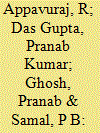

|
|
|
|
|
| Summary/Abstract |
Proof and trial activity in a dynamic test range is a complex, sensitive, and herculean activity. It is a system comprising critical functions that accept various armament inputs and produces proof results as output, processing various critical data and sensitive activities in between. Automation of the existing system is a step for reliable, secure, smooth operation and easy maintainability of the system that makes it synchronized with the latest development of range technology. Understanding the flow of data through these functions requires extensive study to realize different inter-linked activities involved with the functions of this system. This paper presents the flow of activities in the automation of dynamic test range of Proof & Experimental Establishment through context level diagram, process flow diagram, data flow diagram, and entity-relationship diagram. Realization of armament integrated management system will be through resilient and high bandwidth network backbone which is a part of this paper. Cloud computing is the latest development in the information technology. This paper also analyses the appropriate model of cloud computing for porting the system in the cloud.
|
|
|
|
|
|
|
|
|
|
|
|
|
|
|
|
|
|
|
|
|